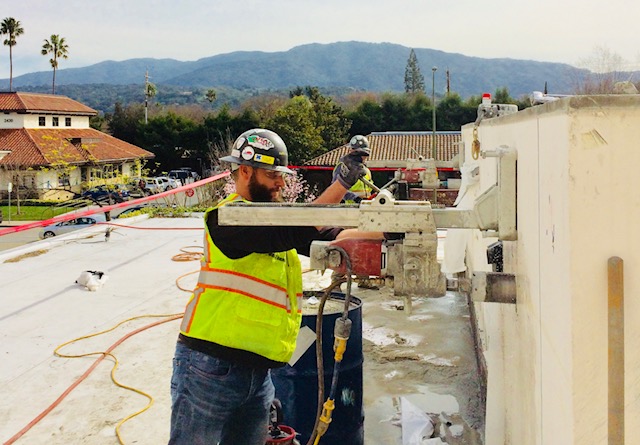Safe2Core is pleased to announce the opening of our latest state of the art ground penetrating radar testing location to serve the Austin & San Antonio Texas Areas!
S2C Texas Inc. is broadening our reach and bringing our capacity for nondestructive forensic concrete scanning Austin residents can trust to San Antonio, TX, the state capitol and surrounding areas. Our ground penetrating radar (GPR) concrete scanning services are suited to projects and concrete structures of all sizes and kinds, from single-family home slab-on-grade and well planning to major industrial construction, retrofitting or post-construction analysis and evaluation by your project’s structural engineer and our dedicated staff.
We proudly offer concrete scanning and other services including:
- Concrete scanning using GPR and X-ray methods
- Concrete cut and core operations
- Locating post-tensioning cables (PT cables)
- Subsurface utility locating, planning and investigation
- Selective demolition and robotic demolition planning
- Well placement and planning
- Underground pipe and utility video inspection
- And much more!
Ground Penetrating Radar
Our proven GPR equipment consists of a concrete scanner that uses radio waves to aid in structural inspection operations including slab thickness evaluation and concrete cutting or coring and drilling operations, including wall sawing, avoiding wire sawing of electrical conduits, and utility location, just to name a few. With our combined four decades of experience in concrete ground penetrating radar scanning, testing, coring, drilling, and cutting, we are proud to have and maintain a safety and success rating unrivaled in the industry.
And now, we’d like to put that experience and dedication to work for you.
To celebrate our newest location and to demonstrate why Safe2Core is the right choice for your Austin concrete scanning and underground investigatory needs, S2C Texas Inc. is offering 20% off first-time GPR scan booking for new clients. It’s a great opportunity to get to know us and see what we can do for your project while saving yourself and your company time, money, hassle, and avoiding potentially costly repairs caused by not knowing what’s beneath your slab-on-grade or lurking inside that wall.
To learn more about Safe2Core and our services, or to find out more about how you can save 20% off your first booking with us, we invite you to visit Safe2Core.com today.
Frequently Asked Questions About GPR
Question: What is concrete GPR scanning? –Michael, San Antonio, TX
Answer: Ground penetrating radar sends radio waves into the surface to be tested and measures the reflections sent back by obstructions and dense materials below. Using this information in conjunction with structural and utility drawings and as-built site data, we can determine the location of reinforcing steel (rebar) as well as electrical, water and gas lines, and other utilities. This helps facilitate forensic structural inspections, utility planning, well placement and concrete cutting, drilling, and coring operations.
Question: What do you do if you need to cut, drill, or core into concrete? –Sylvia, Port Aransas, TX
Answer: Cutting into concrete in any fashion requires three things: a bit or blade capable of cutting through the hardened surface, knowledge of what the concrete contains and caution to avoid penetrating or cutting anything you don’t intend to. The most common concrete-cutting blades are impregnated with industrial-grade diamond, making them exceptionally hard and durable. Most concrete cutting and coring machines use water to keep the blades cool, expedite cutting and provide lubrication between the blade surface and the concrete. Using GPR, X-ray analysis or both can help determine what lies under the surface and help guide cutting, coring, and drilling.
Question: Can GPR concrete scanning determine rebar diameter? –Martin, Concan, TX
Answer: Theoretically, yes, it can. GPR measures the reflected radio waves given off by obstructions and dense areas within the concrete. If the GPR return maps out a grid beneath the concrete, it is reasonable to say that grid is almost certainly the rebar. Working from the drawings and construction documents, we can verify the number and thus the diameter of the rebar. However, in the field, we can only estimate rebar diameter and strongly caution against relying upon these estimates for cutting and coring operations without verification of the rebar number(s) in place.
Question: Can ground-penetrating radar detect corroded rebar? –Linda, New Braunfels, TX
Answer: Yes, it can. As rebar corrodes, its density changes, although the placement will remain largely the same, typically in a grid or box formation. Experiments in both the laboratory and field have confirmed that GPR can be used to locate and identify areas of corrosion within the rebar mat.
Question: Can GPR distinguish between rebar and voids in concrete? –Antonio, Terrell Hills, TX
Answer: Most certainly! GPR concrete scans send radio pulses into the surface, which are either absorbed or reflected back to the scanner and analyzed. Based on the amount of signal which is returned and the time it takes for the radio waves to be returned, we can determine what the scanner is picking up. Rebar, being hardened steel, has a high density and a commensurate reflective signature. Since a void is by definition a “hole” or crack in the concrete where there is no or very little material, the signal in the area of the void would keep going until it encountered something dense enough to cause it to reflect. Using this data, we can determine the size and approximate shape of the void, giving your engineering team the information they need to determine what measures should be taken to correct the issue.





